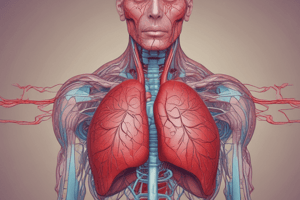Podcast
Questions and Answers
What is the primary function of the aorta?
What is the primary function of the aorta?
- Regulate blood pressure within the heart
- Pump oxygen-rich blood to the body
- Carry oxygen-rich blood from the heart to the rest of the body (correct)
- Transport deoxygenated blood to the lungs
Which function is not performed by the kidneys?
Which function is not performed by the kidneys?
- Remove waste products and excess fluid
- Convert nutrients for energy production (correct)
- Maintain acid-base balance
- Regulate electrolyte concentrations
What role do the pulmonary veins serve in the circulatory system?
What role do the pulmonary veins serve in the circulatory system?
- Transport oxygen-rich blood from the lungs to the heart (correct)
- Carry blood from the heart to the rest of the body
- Carry oxygen-poor blood to the lungs
- Pump deoxygenated blood to the right atrium
Which part of the urinary system is responsible for storing urine?
Which part of the urinary system is responsible for storing urine?
Which layer of the heart is the innermost layer?
Which layer of the heart is the innermost layer?
What is defined as the peak maximum pressure released by the heart during contraction?
What is defined as the peak maximum pressure released by the heart during contraction?
What is the primary function of bile?
What is the primary function of bile?
What causes the control of blood flow from the right atrium to the right ventricle?
What causes the control of blood flow from the right atrium to the right ventricle?
Which of the following vessels carries blood from the heart to the lungs?
Which of the following vessels carries blood from the heart to the lungs?
Which of the following is not a function of the liver?
Which of the following is not a function of the liver?
Flashcards
Aorta function
Aorta function
Transports oxygen-rich blood from the heart to the rest of the body.
Superior Vena Cava
Superior Vena Cava
Carries deoxygenated blood from the upper body to the heart.
Pulmonary Artery function
Pulmonary Artery function
Carries oxygen-poor blood from the heart to the lungs.
Right Atrium function
Right Atrium function
Signup and view all the flashcards
Left Ventricle function
Left Ventricle function
Signup and view all the flashcards
Arteries vs Veins
Arteries vs Veins
Signup and view all the flashcards
Systolic Pressure
Systolic Pressure
Signup and view all the flashcards
Diastolic Pressure
Diastolic Pressure
Signup and view all the flashcards
Kidney function
Kidney function
Signup and view all the flashcards
Gallbladder function
Gallbladder function
Signup and view all the flashcards
Study Notes
Cardiovascular System
- The aorta transports oxygen-rich blood from the heart to the body.
- The superior vena cava carries deoxygenated blood from the upper body to the heart.
- The inferior vena cava carries deoxygenated blood from the lower body to the heart.
- The pulmonary artery carries blood from the heart to the lungs.
- The pulmonary vein carries oxygen-rich blood from the lungs to the heart.
- The right atrium receives oxygen-poor blood from the body and pumps it to the right ventricle.
- The left atrium receives oxygen-rich blood from the lungs and pumps it to the left ventricle.
- The right ventricle pumps oxygen-poor blood to the lungs.
- The left ventricle pumps oxygen-rich blood to the body.
- The aortic valve controls blood flow into the aorta.
- The pulmonary valve helps oxygen-poor blood reach the lungs.
- The tricuspid valve controls blood flow from the heart's top chamber (right atrium) to the bottom chamber (right ventricle).
- Arteries carry blood away from the heart.
- Veins carry blood to the heart.
- Capillaries are thin-walled blood vessels where gas exchange occurs.
- Blood pressure has systolic (highest) and diastolic (lowest) components.
- Systemic circulation carries oxygenated blood throughout the body.
Hepatobiliary System
- The liver is involved in metabolism, converting nutrients and detoxifying substances.
- The liver produces bile, which aids in fat digestion.
- The gallbladder stores and concentrates bile.
- Layers of the heart wall include epicardium (outermost), myocardium (middle), and endocardium (innermost).
- Liver cells (hepatocytes) are the functional units of the liver.
- Kupffer cells are resident macrophages that remove foreign debris.
- The liver filters toxins, regulates blood glucose levels, and produces immune factors.
Urinary System
- Kidneys remove waste products and excess fluid from the blood.
- Kidneys help maintain homeostasis in the body.
- Kidneys regulate acid-base balance, electrolyte concentrations, and extracellular fluid volume.
- The urinary system includes the kidneys, ureters, bladder, and urethra.
- Kidneys are responsible for maintaining blood pressure.
- Causes of kidney problems/diseases include congenital abnormalities, diabetes, and high blood pressure.
Studying That Suits You
Use AI to generate personalized quizzes and flashcards to suit your learning preferences.



